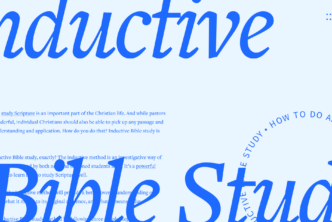My parents were Bible translators for an unreached people group in northern Brazil, and I was therefore blessed to watch the Word of God radically transform not just individual lives but a whole culture. The families in our area were desperately broken; the culture normalized the abuse of children and women.
But as my parents taught and translated the New Testament, I watched fearful, hopeless villages transform into safe havens where women were valued and children loved and protected. Seeing the transformational power of the Word of God gave me a deep, abiding love for it. I struggle—like many from my church background, I think—not to replace the Holy Spirit with the Holy Bible.
My dad started teaching me Greek in third grade; my mother is a Hebrew scholar. Both parents, when they want to know what a passage means, study it in the original languages.
But despite my genes and my early acquaintance with biblical languages—and despite the fact that I myself now train Bible translators in linguistics—I must still rely on study tools like Logos Bible Software to help me benefit from the Hebrew of the Old Testament and the Greek of the New Testament. And one of the most important Bible study tools I rely on—and urge others to rely on—is probably within ten feet of you right now: a “formal” Bible translation.
Two benefits of formal Bible translations
A formal Bible translation is “form-centric.” It sticks as closely as possible to the “forms” of the original language. One of the leading writers on Bible translation, Eugene Nida, has said that a formal-equivalence translation “is basically source-oriented; that is, it is designed to reveal as much as possible of the form and content of the original message.”
Nida names three elements of language that formal translations try to reproduce: “(1) grammatical units, (2) consistency in word usage, and (3) meanings in terms of the source context.” This approach to translation is often labeled with the famously slippery term “literal,” and it is often distinguished from “functional” Bible translations (see the article by Joshua Jensen in this BSM, “What Are Functional Translations Good For?”). Formal translations are good for enabling Bible students to “look through” a language they know to see something of how the original Hebrew and Greek expressed biblical ideas.
For example, look at the way various translations render the key words in Romans 4:4:
- KJV: Now to him that worketh is the reward not reckoned of grace, but of debt.
- NASB: Now to the one who works, the wages are not credited as a favor, but as what is due.
- ESV: Now to the one who works, his wages are not counted as a gift but as his due.
- NLT: When people work, their wages are not a gift, but something they have earned.
The Greek word here is the one usually translated “grace.” But the Greek word can also mean “gift,” unlike the English word. “Grace” here is both unnatural in English and difficult to understand. Even formal translations like the ESV and NASB choose to go with a clearer rendering. But by making the text clear here, possible connections to other passages are less clear. Romans 11:5, for example:
So too at the present time there is a remnant, chosen by grace. But if it is by grace, it is no longer on the basis of works; otherwise grace would no longer be grace.
In a perfect world, all the Bible translators I train would just go study biblical languages at the Hebrew University before they begin their translation work. But for all but a few this is not feasible. Even a basic understanding of the original languages is inaccessible to the majority of believers in the world today. How can native speakers even begin to produce a trusted and trustworthy Bible translation if they do not have biblical language skills?
Native speakers of Chadian Arabic or Falam or Sara Kaba Dem have to form their initial translation using a majority language Bible, often one using a colonial European language such as French, Spanish, or English (then consultants like my parents who know the Hebrew and Greek come in and help them correct that translation against the originals). I teach these native translators the same Bible study process I teach those I am discipling in the US: if they do not know the biblical languages, I point them to a formal Bible translation.
A benefit and a problem with functional translations
Formal translations are helpful for my Bible translator trainees for the same reason they’re helpful for you. Let me explain by raising a question: What would be the harm (other than copyright violations) if they translated from a more functional, easier to understand translation such as the New Living Translation or New International Version? And here in the US, for that matter, what is the harm in my teaching a new Christian to read a functionally equivalent translation? Both the church or people group with no Bible in its language and the maturing believer go through a similar development process.
A few years ago we read through the Immerse New Testament—which uses a functional translation—with our early teenage sons. It was a fantastic experience. I would highly encourage anyone to use it with young or new believers. It gave them an understanding of the testament as a whole; the overarching story of Scripture was clear to them; and scriptural themes jumped out at us all. My husband and I were surprised at how much we learned from and enjoyed the experience.
There is so much to learn when you first begin reading the Word of God, and functional translations are great ways to gain a broad understanding of the scope and message of the Word. When I am training Bible translators for language groups that are largely unreached, they tend to lean toward functional or meaning-based translations. Their focus is to help people with no background in Scripture to understand the meaning of the gospel.
But there is a problem with functional translations. When I teach this concept to Bible translators, I use the example of the old telephone game they had us do in youth group (usually to teach us the dangers of gossip!). By the time the dozenth person in line said the message out loud, it bore little resemblance to the original.
The same problem occurs when translating or studying only from a functional translation. The translators have to make so many little decisions about how to translate the meaning from the form that something invariably gets lost—or added—in translation. Whether or not those somethings are critical to the message will vary from language to language and passage to passage. The best way to make sure you get as many of these pieces of meaning as possible is to read formal translations.
The value of multiple kinds of Bible translation
If you rely on functional translations alone in Bible study, you are less likely to find that a given Hebrew or Greek word is consistently translated with a particular English word. Such translations are not as useful in studying the development of biblical concepts throughout the canon of Scripture—“grace,” for example, or “servant” (see sidebar). Formal translations are not as good as functional ones for communicating the big picture quickly, but they enable students of the Word to dig more deeply into the significance of the individual words God inspired.
I work with a Bible translation organization, unfoldingWord, that sees the need for both kinds of translation. They provide native Bible translators with a functional translation and a formal translation in the local “Language of Wider Communication” (Spanish, Russian, Hindi, English). The formal translation enables the translators to see more of the forms of the original texts and their implications for their word choices. The functional translation enables them to better understand the meaning so they can communicate it clearly in their own language.
I would encourage any serious student of the Bible to learn from my experience as a Bible translator: always have a formal translation such as the ESV or NASB and a functional translation such as the NLT open as you study. I often use the World English Bible as a reference, because I teach internationally and I find its English to be more understandable to people who speak English as a second language. I also always have my King James open, because that’s what I memorized as a child so I cannot find verses in anything else.
I said earlier that the process churches go through in translation is similar to that of a maturing believer. As the church grows and matures, it rarely sees a functional translation as sufficient for pastors, teachers, and Bible colleges. Just like the English speaking church finds translations based on different approaches beneficial for outreach, study, and growth, so does the global church. Both formal and functional translations are useful for Christians everywhere.

***
This article was originally published in the March/April 2021 issue of Bible Study Magazine. Slight adjustments, such as title and subheadings, may be the addition of an editor.
Related articles
- The Best Bible Translations: All You Need to Know & How to Choose
- Bible Translations: Wisdom in Choosing the Right One
- 29 Bible Study Tools for Reading the Bible More Effectively
Related resources





